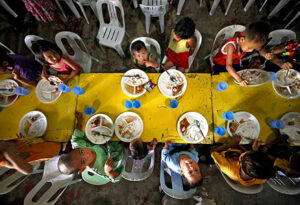
08 Dec The urgency of investing in proper nutrition in the ‘First 1,000 days’
Proper nutrition in the first 1,000 days after conception is essential for ensuring children will grow as thriving adults. This is the period from pregnancy until the child’s second birthday when most development takes place — offering a critical window of opportunity to shape a child’s future.1 The conditions and the nutrition infants are exposed to during their first 1,000 days may either make or break a child’s potential for optimal development.
While the first 1,000 days is a great time to set our children up for success, this is also the period when they are highly vulnerable to impairments and health issues. According to the Developmental Origins of Health and Disease (DOHaD) theory, the early environment of each child within the womb, dependent on the health and nutrition of the woman during pregnancy, has the most influence on the child’s vulnerability to adult-onset diseases such as obesity, diabetes, cardiovascular disease, and certain cancers.2
In the first 270 days, if a pregnant girl or woman fails to receive the proper nutrition she needs, the growing fetus will have to adapt and compensate for the limited nutrition it gets. This lack of adequate nutrients is the root cause of suboptimal in-utero growth of organs, leading to increased risk of acquiring diseases later on in life. Thus, if the mother is unhealthy to begin with, a child will most likely be unhealthy as well.
The brain develops the fastest during these first 1,000 days. Such rapid development requires the right nutrition to facilitate neural connection and support proper cognitive functioning.3After birth, the brain, along with the liver and the immune system, remains plastic. This means these organs retain their capability to adapt, change, and develop further depending on the child’s immediate environment.4 In the next 180 days after birth, the infant should be exclusively breastfed.
At six months of age, an infant starts having solids to complement the nutrients in breastmilk while breastfeeding continues up to two years of age or beyond. These complementary solids are preferably home-prepared from family foods, locally available and safe, and nutrient-dense but without added sugars and salt. If these recommended Infant and Young Child Feeding practices are not followed, underweight, acute undernutrition (wasting), and chronic undernutrition or stunting can ensue; development will be compromised and may lead to irreversible cognitive impairment and reduced learning capacity. Conversely, if the infant is fed unhealthy food that is high in sugar, fat, or salt, the child will likewise be affected with malnutrition, just in a different way — with overnutrition manifested by being overweight or obese.
Here are three figures from the Philippine Plan of Action for Nutrition (PPAN) 2023-2028 that illustrate the trends in both under- and overnutrition among infants, young children, and adolescents.
For more than two decades now, we have failed to make meaningful progress in eradicating wasting among our under-five children. Stunting prevalence has declined but is still considered “high” by the definition of the World Health Organization. In addition, we see an alarmingly rapid rise in the prevalence of overweight and obesity among school-age children (five- to nine-year-olds), from 8.6% in 2015 to 14% in 2021. A similarly stagnant prevalence of wasting, high prevalence of stunting and rising prevalence of overweight/obesity are evident in our adolescents.
The irreversible impact of malnutrition on children and adolescents is of urgent concern. The consequences of malnutrition, particularly during the first 1,000 days of life, will continue to haunt them even through adulthood.
Undernourished young infants and children will likely grow up to be adults with difficulties in learning and forming right judgment, directly impacting their decision-making skills.
This translates to a life characterized not just by poor academic performance but also missed opportunities as these children struggle to learn income-generating skills. Hence, they grow up to be adults who are less productive than their healthier counterparts, leading to a significant decrease in their average income.
The impact of malnutrition is intergenerational. Children of poor and food insecure families grow into adolescents and adults ill-equipped to fight their way out of the oppressive chain of poverty. In turn, they may beget malnourished children who will most likely suffer the same fate. The question is, how much longer must this go on?
For the Philippines, the annual estimates of the staggering costs of inaction on stunting, anemia in children, women, and girls, low birth weight and exclusive breastfeeding have been made.5 Our children are struggling to learn basic academic skills such as reading and writing, science, and mathematics. We are the lowest ranking country in the Program for International Student Assessment (PISA) 2024, and we have always been below average since we joined the said assessment in 2018.
We suffer from $4.5 billion or about P240 billion worth of economic losses due to low productivity, morbidity, and premature deaths as a result of childhood malnutrition. Likewise, several cases of life and productivity loss in the Philippines are caused by inadequate nutrition and an unhealthy environment during childhood.
Resources allocated for the nutrition of our children must be increased to ensure adequate interventions are sustained, especially to meet the country’s performance target of hitting its 2030 Sustainable Development Goals of Zero Malnutrition. So far, the country has made little to no progress at all.
(In the next piece of this series, we will investigate what measures we might take in battling both under- and overnutrition in the First 1,000 Days more judiciously.)
11,000 Days. (Feb. 9, 2024). “Why 1,000 days.” Retrieved Dec. 4, 2024, from https://thousanddays.org/why-1000-days/
2Yale School of Public Health. (n.d.). “Developmental origin health & disease.” Yale School of Public Health. Retrieved Dec. 4, 2024, from https://ysph.yale.edu/public-health-research-and-practice/department-research/environmental-health-sciences/developmental-origin-of-health-and-disease
3Moore, T.G., Arefadib, N., Deery, A., & West, S. (2017). “The First Thousand Days: An Evidence Paper.” Parkville, Victoria; Centre for Community Child Health, Murdoch Children’s Research Institute.
4Barker, D.J.P. (2012), as cited in Moore, T.G., Arefadib, N., Deery, A., & West, S. (2017). “The First Thousand Days: An Evidence Paper.” Parkville, Victoria; Centre for Community Child Health, Murdoch Children’s Research Institute.
5Jain, S., Ahsan, S., Robb, Z., Crowley, B., & Walters, D. (2024). “The cost of inaction: a global tool to inform nutrition policy and investment decisions on global nutrition targets.” Health Policy and Planning, 39(8), 819-830. https://doi.org/10.1093/heapol/czae056
Ma. Dhelyn Dela Cruz and Rosheic Sims are researchers and communicators for the fiscal and health policy team at Action for Economic Reforms (AER). Dr. Maria Asuncion Silvestre is a World Health Assembly Laureate (2023), recipient of the United Arab Emirates Health Foundation Prize, and the founding president of Kalusugan ng Mag-Ina (KMI).
